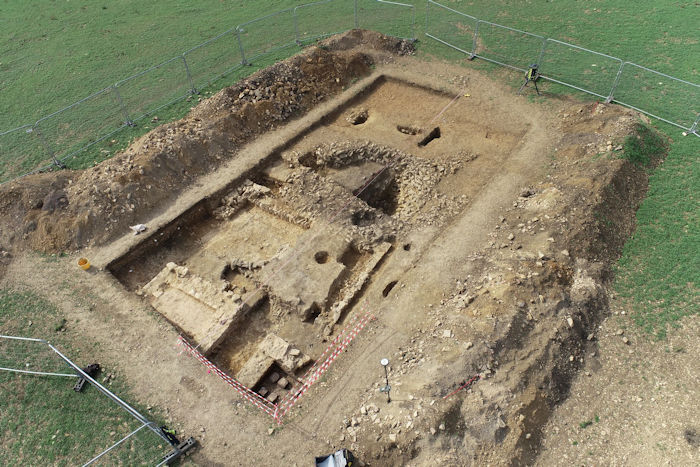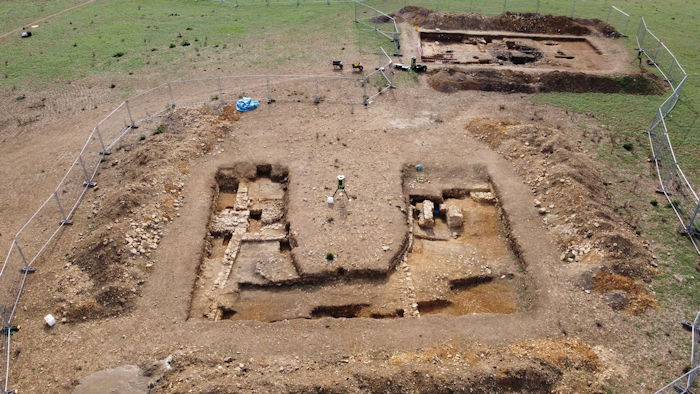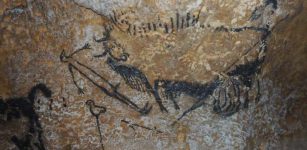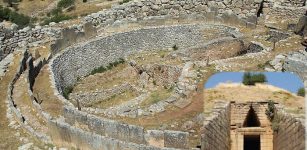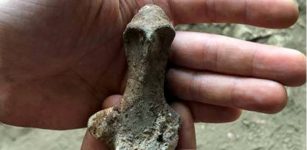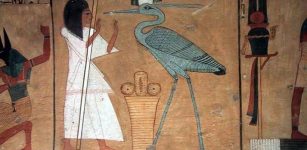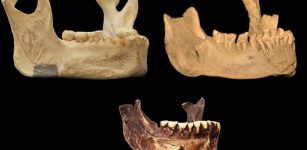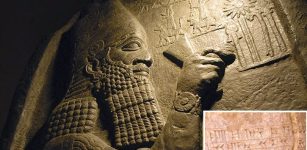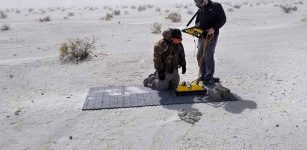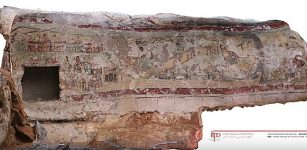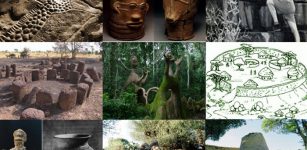Amazing Finds At Rutland Roman Villa Reported By Archaeologists
Conny Waters - AncientPages.com - Archaeologists report they have made more amazing finds at the Roman villa site in Rutland, UK.
Dating back to the third or fourth century A.D., the villa complex was first discovered on farmland in 2020. Following investigative work by a team from the University of Leicester Archaeological Services (ULAS), working in partnership with Historic England and in liaison with Rutland County Council, it was awarded Scheduled Monument status in November 2021.
The expanded excavation has uncovered more details of living complex, including expensive materials such as parts of broke pillars, which hint at the owners' wealth. Image: Historic England
Last year archaeologists unearthed a rare Roman mosaic depicting the adventures of the Greek hero Achilles and the Trojan War at the site. The discovery, dating back to the late-Roman period, was considered one of the most exciting of its kind in the past century.
However, it's clear the Rutland Roman Villa has more valuable ancient secrets to reveal.
Archaeologists said they were "gobsmacked" to find more lavish buildings and another mosaic when they returned to the area in Rutland.
The impressive mosaic is one of only a handful across Europe. Image: Historic England
From the new excavations the team has gathered more insight into the complex, which was occupied in the late Roman period, between the 3rd and 4th century AD. The team covered a wider area to investigate multiple buildings.
Changing rooms - one of Britain’s earliest barn conversions
The team examined a building similar in size to a small church, revealing a large and well-preserved structure that probably started as an agricultural timber barn. The building was supported by large timber posts and could have had two storeys. It was converted to stone in the 3rd or 4th century, and one end turned into a dwelling area, while the other end was retained for agricultural or craft work.
Jennifer Browning, from the university's archaeological team, described the site as "amazing." Image: Historic England
The dwelling had many floors still intact and a complicated sequence of internal walls, illustrating that it had been in use for a long period of time and had undergone a series of interior changes. But the standout feature was a Roman-style bath suite consisting of a steam/hot room, a warm room, and a cold plunge pool.
There is evidence of sophisticated underfloor heating that used different techniques to maintain varying temperatures and heating ducts built into the walls. It is thought that the floor of a water tank situated outside the building might have been used to collect water from the roof.
Although the team cannot conclude if the owners were from overseas or native to Rutland, the findings indicate that the occupiers were making lifestyle choices to associate themselves culturally with the Roman Empire.
Design masters – grand decoration and materials point to wealthy owners
The team also returned to where the Trojan War mosaic was found. It is thought that the mosaic was laid out in a dining room (known as a triclinium), which was within what appears to have been the main villa building.
Painted wall plaster, fragments of polished marble and broken stone columns hint at the grand decoration in the room to accompany the mosaic – some of which would have been imported materials, indicating the considerable wealth and influence of the villa’s owners.
The dining room was a later addition to the main villa building, suggesting that the owners wanted to show off their wealth and knowledge of Roman culture by building a new area for feasting, while gazing out over the ancient story told on the mosaic.
This drone image of the site captures an area of the villa thought to be the main reception. Image: Historic England
The expanded excavations revealed even more detail about the extensive decoration of this villa. Further mosaics would have graced the floors of corridors leading to the dining room: on the western side, fragments of a patterned design had collapsed into a disused underfloor heating system, while the eastern corridor contained a well-preserved mosaic with a kaleidoscopic geometric design, probably of similar date to the Trojan War mosaic.
In other areas on the complex, a variety of buildings of different sizes was revealed, suggesting a thriving villa set-up associated with a range of activities.
Historic England’s Chief Executive, Duncan Wilson, said: “This is a fascinating site and has posed many questions about life in Roman Britain. The answers will become clearer as the evidence is examined over the next few years by a team of specialists, and their work will help us understand the story of this villa complex, and its significance for our understanding of Roman Britain.”
John Thomas, Deputy Director of ULAS and Project Manager of ULAS excavations, said: “It’s difficult to overstate the significance of this Roman villa complex to our understanding of life in late Roman Britain. While previous excavations of individual buildings, or smaller scale villas, have given us a snapshot, this discovery in Rutland is much more complete and provides a clearer picture of the whole complex.
‘’The aim of this year’s work has been to investigate other buildings within the overall villa complex to provide context to the Trojan War mosaic. While that is a wonderful, eye-catching discovery, we will be able to learn much more about why it was here, and who might have commissioned it, by learning about the villa as a whole.
A newly found mosaic at the site. Image: Historic England
“We are delighted to once again be working in partnership with Historic England on this project and pleased that this latest phase of the project – the final excavations on the site for the foreseeable future – will enable us to offer valuable real-world experience to Leicester’s Archaeology students and opportunities for community volunteers.”
Ian Barnes, Historic England Senior Archaeologist and Project Manager of HE excavation, said: “This year’s excavations by Historic England and ULAS have further revealed what a remarkable place this was during Roman times. A place built for comfort, and clearly to impress – but who?
“I’m looking forward to the analysis of our findings, which will tell us so much more about the people who lived here, and their connections. Just as exciting was the chance to work with over a hundred people over the summer, in partnership with ULAS, and including University of Leicester students, volunteers from the local community and Historic England staff learning new skills: hopefully the experience has not only brought them into close contact with the Romans but also taught them much about archaeology, and something about themselves.”
MP for Rutland and Melton, Alicia Kearns, said: “It is fantastic news to hear that further Roman interior wonders have been uncovered at this historic Rutland villa complex. This exciting discovery is of great historical significance to paint a clearer picture of life in Roman Britain at the time and provide us with a complete story behind the villa site overall.
A piece of decorated tile from the recent excavations. Image: Historic England
“These excavations will also provide a brilliant opportunity for Leicester’s Archaeology students and local volunteers from our communities to gain valuable archaeology experience. I look forward to hearing from the team at Historic England and ULAS over the coming months as we learn more about these findings and the villa in its entirety and plan for how to ensure the public get to see it too.”
Rutland County Council Portfolio Holder for Culture, Councillor Marc Oxley, said: “These wonderful further finds paint a vivid picture of the cultural life of our ancestors in Roman times. A fascination with art, design, architecture, storytelling and fine dining are part of our common heritage and bring to life our understanding of the past.
See also: More Archaeology News
“It was a real privilege to be able to visit the site earlier in the year, and I’d like to express our tremendous thanks to the landowners, Historic England, ULAS, and the archaeologists, specialists and volunteers who have undertaken this painstaking work. We look forward to being able to learn more about life in Roman Rutland, and to help exhibit selections of these remarkable discoveries in the county.”
Written by Conny Waters - AncientPages.com Staff Writer

